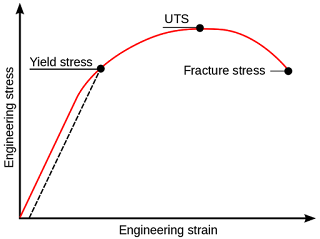Factor of Safety
From the
stress-strain curve we note that ultimate stress is the maximum value of
stress, the material withstands before failure.
So, should we
allow the material to reach its ultimate stress value while in operation?
The answer is
No..! as we would like to keep some scope for safety, since the estimated
operation loads may be exceeded at time. Also, the ultimate stress value may be
different from that of the tested specimen.
Hence, the
actual stress is kept much below the ultimate stress limit. In fact, ideally
the stresses should be kept within the elastic limit. The upper limit up to
which the stresses are permitted is known as the permissible stress or
allowable stress or safe stress or working stress.
The ratio of
Ultimate stress to safe stress/Working Stress know as Factor of Safety. It works as a
protective shield against failure of material under stress.
The factor of
safety for a component or structural part has to the be chosen very carefully.
If chosen too small, the possibility of failure becomes dangerously large and
if chosen very large, the design can become uneconomical. Generally, the choice
of factor of safety for a component is influenced by the flowing
considerations:
Material Properties:
Material used for a component may not be
homogeneous, i.e., it may not have the same properties throughout. The
composition, strength and its dimensions may have small variations during its
manufacture. The properties are also altered when a material undergoes various
heat treatments.
Type of Loading:
A designer may keep in mind the type of
loading (static, impact, reversal, etc.) a structure is going to withstand; yet
there are possibilities of inaccuracy in his estimates. There can also be
alterations of use of a structure with time.
Number of Loading:
The actual number of loading during the
life of a component may be different from the expected loading at the time of
designing. The ultimate stress usually decreases with increase in the number of
loading. This phenomenon is known as fatigue and plays a key role in designing.
Type of Expected
Failure:
Sometimes, the collapse of a structure
may occur suddenly and there is no prior indication as in case of brittle
materials. In such cases where there is possibility of sudden failure, a higher
factor of safety has to be used then where there is possibility of pre-warning
in the form of yielding of the material.
Method of Analysis:
As all relations and analyzing methods
are based on certain assumptions, it is appropriate to include some factor of
safety for such type of assumptions and simplifications.
Maintenance:
All mechanical components and
structures require good maintenance during their lifetime. However, to consider
poor maintenance, rusting, corrosion, decay and other natural uncertainties in
future, some margin has to be included.
Few
more piping resources...
- Stress Analysis of Column Piping System - 01
- Stress Analysis of Column Piping System: PIPING &COLUMN MODELLING IN CAESAR-II
- Basics of Pipe analysis: Objectives
- Basics of Pipe analysis: Principal stresses
- Piping Stress Basic
- Piping Stress analysis













0 Comments
Please do not enter any spam link in comment box